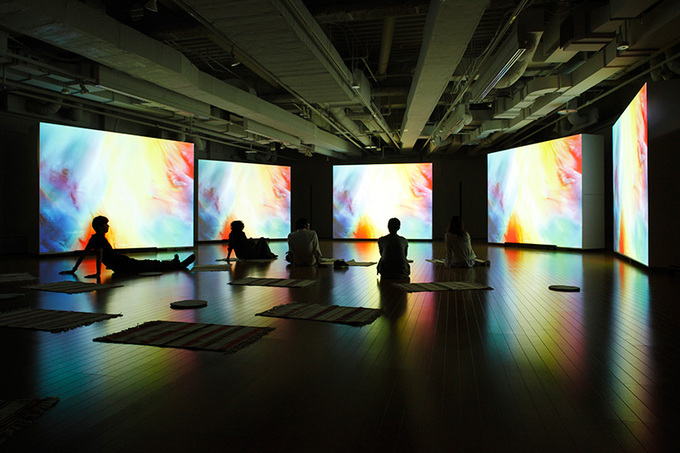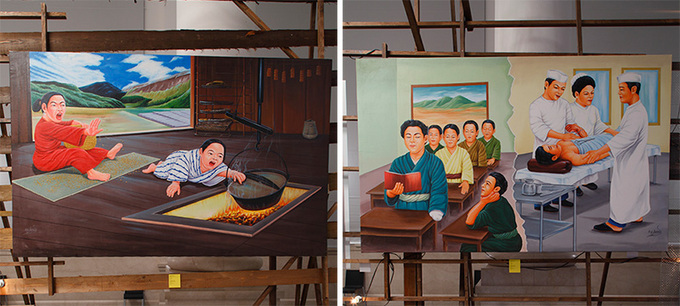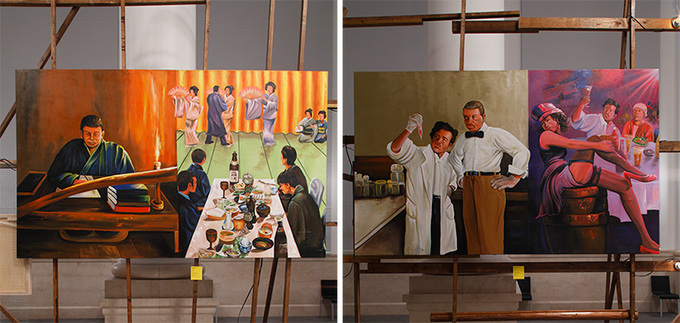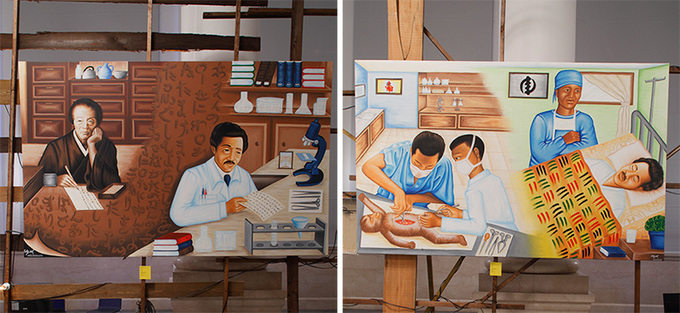Tsuyoshi Ozawa/ Masakatsu Takagi Going through Africa ―Two Artists Linking Japan and Africa | Dr. N's Theater of Life: Tsuyoshi Ozawa Links Ghana and Fukushima
Masakatsu Takagi, Tsuyoshi Ozawa, and Yukie Kamiya
In conjunction with the 5th Tokyo International Conference on African Development (TICAD V) held in Yokohama in June 2013, the Japan Foundation presented an exhibition entitled "Tsuyoshi Ozawa/ Masakatsu Takagi Going through Africa--Two Artists Linking Japan and Africa" at the Yokohama Creativecity Center (YCC) from May 25 to June 9, 2013.
In preparation for the exhibition, two notable Japanese artists visited Africa and each created a new art work inspired by their encounters with local people and the experiences and information gained through their travels. Contemporary artist Tsuyoshi Ozawa's trip to Ghana culminated in the installation that he named The Return of Dr. N. Visual artist and musician Masakatsu Takagi travelled to Ethiopia where he put together the unique video piece Utagaki.
Utagaki by Masakatsu Takagi
Ethiopia is an African nation with a distinct history and culture. During the trip, visual artist and musician Masakatsu Takagi captured a series of video and photographic images of the people he met in farming villages across the country. These images were transformed into a video work abounding in originality that centers on the Ethiopians and, more specifically, the Ethiopian children's hopes, dreams and prayers.
Far away in Ethiopia,
I have been there surrounded by eyes sparkling like sunshine,
and vocal melodies felicitating something unknown to me.
In the flood of colors that can be discovered going deep into the light,
if we focus our mind, we feel everything singing and dancing.
In the flow of time passing away hurriedly, if we focus our mind,
we feel everything singing and dancing.
That is just what I wish the film would be like.
Just like a picture diary we used to make in our childhood,
I wish the film portray my memories,
keep what I felt in that far land. --Masakatsu Takagi

A five-channel video installation projecting the dynamic and beautiful images
The Return of Dr. N by Tsuyoshi Ozawa
Contemporary artist Tsuyoshi Ozawa chose to focus his work on bacteriologist Dr. Hideyo Noguchi, who travelled to Ghana to study yellow fever almost a century ago and died there. Adding his own mix of interpretation and fiction to the real life and achievements of the researcher, Ozawa created the imaginary character of "Dr. N" whose tale is represented in the installation work The Return of Dr. N.
(Photos of the art works and installation views are at the bottom of the page)
Dr. N's theater of life: Tsuyoshi Ozawa links Ghana and Fukushima
Yukie Kamiya
Chief Curator, Hiroshima City Museum of Contemporary Art
Probably everyone living in Japan knows the story of the great Hideyo Noguchi. Known in his childhood years as Seisaku. Born 1876 in Inawashiro, Fukushima; died 1928 of yellow fever in Accra, Ghana. Bacteriologist whose international career included success in culturing the syphilitic spirochete. Dedicated to the study of yellow fever.
For his new project with an African theme, contemporary artist Tsuyoshi Ozawa focused on Hideyo Noguchi, a real-life person and face on the 1000-yen note who traveled to the African nation of Ghana almost a century ago, retracing the steps of this member of the first generation of Japanese with the chance to become citizens of the world, who amid the seismic social upheaval that occurred from the Meiji Restoration through the Taisho and into the Showa era moved beyond his home nation to a far larger stage, struggling and taking advantage of every opportunity that came his way. Adding his own mix of interpretation and fiction to the portrait of Noguchi, Ozawa then created the complex and idiosyncratic character of "Dr. N." The story of Dr. N's turbulent and occasionally plain preposterous existence is no simple work of fantasy: transcending past and present, cultural differences and geographical distance, it links Japan and Africa, and encourages us to ponder issues confronting us in today's world.
Hideyo Noguchi: Unknown faces of a great man
Hideyo Noguchi possessed many different faces.
First there is that of the great Noguchi, hardworking individual of indomitable will. Born into a poor farming family, at the age of one and a half Noguchi fell into the fireplace and badly burned his left hand. But having inherited his mother Shika's persevering nature and work ethic, he refused to be defeated by his handicap, and was a top-performing student. Becoming an assistant at a hospital in Aizu-Wakamatsu, Fukushima, he toiled tirelessly, mastering French and English. Immersing himself in his studies, he eventually qualified as a doctor. Noguchi's language skills bore fruit, leading to posts at the Kitasato Institute for infectious diseases, the Yokohama quarantine station, and as part of a team traveling to Qing-dynasty China to work on plague prevention. Then, having volunteered his services as an interpreter for a visiting US professor, he traveled to the United States, where after working as the professor's assistant he took the opportunity to move to the newly-established Rockefeller Institute for Medical Research, forging ahead with his own research and embarking on a career of global reach that included lecturing in Europe, and research expeditions to South America and Africa.
Yet at the same time, Noguchi lurched from one farcical episode to another, bludging cash for course fees and living expenses from acquaintances, and exhibiting a reckless streak of self-indulgence that would see him sqaunder in a single night the funds provided by a patron for study abroad. When it came to money sense, it would seem Noguchi was somewhat lacking.
Noguchi also had more than a few connections to art. It was Ichiro Hori (1879-1969), living nextdoor to Noguchi in the same New York apartment building, who initiated the workaholic research-obsessed Noguchi into the art of oil painting. Having seen his father lose his livelihood as a retainer of the former Matsue clan of Shimane after the Meiji Restoration, determined to acquire a trade the young Ichiro studied photographic techniques under a photographer follower of Japanese photography pioneer Hikoma Ueno, then traveled to the United States. There he built a successful reputation as a photographer, including for portraits of Broadway actors. When Noguchi was confined to bed with a bout of typhus, Hori gave him a set of oil paints, which the researcher used to paint those close to him such as his mother, his mentors, and his wife Mary. After Noguchi's death Hori returned to Japan and became a painter. A portrait of Noguchi by Hori was gifted to the Japanese ambassador's official residence in Ghana, and remains in Africa to this day.
The period during which Noguchi lived was one that saw Japanese society swept by momentous changes from the Meiji Restoration onward, and an era of imperialism that encompassed Japan's wars with China and Russia, followed by the First World War. Japanese engaging with the wider world for the first time were idolized solely on the basis of their international success, and the image of Noguchi as a towering figure took on a life of its own. The misconduct that later came to light, and Noguchi's capacity to behave in a less than genteel manner when survival was at stake, may be seen not so much as character faults, but indicators of his real, only too human side. Support for Noguchi as an adored figure in Japanese history is also evident from the vast number of books penned about him.
Mixing humor and fiction, Ozawa's works frequently use a method one could describe as honkadori, that is, drawing on an older original. His Museum of Soy Sauce Art series (1999 - ) for example reflects on art history by reworking in a museum-style format numerous important works from Japanese art history, via the extraordinary idea of painting them in the quintessentially Japanese condiment of soy sauce, Ozawa having created the imaginary genre of "soy sauce painting." As well, he turns his gaze to the nostalgic, the slightly old-fashioned, and weaves them into his works, blowing holes in the usual way we see things, in conventional, authoritative notions, and leading us to a new way of seeing the world. Examples include Nasubi Gallery (1993 - ) and University of Sodan Art (1995), which incorporate with all the solemnity of children's role play the gallery and university systems. Using Noguchi's life story as a base, Ozawa has returned to today's Fukushima, and through the imaginary figure of Dr. N, who confronts the threat not this time of invisible bacteria but invisible radiation, takes a distant time and space and transposes it on our shared everyday reality.
Translating the story using the sign paintings and music of Ghana
Striding ambitiously out into the world, working tirelessly, tenaciously grasping even the smallest opportunity. Inspired by Noguchi, whose diminutive frame was armed with the global outlook and boundless energy he needed to forge a bond between Africa and Japan, Ozawa headed for Ghana, where Noguchi was eventually to meet his end. There Ozawa ordered from a local painter eight signboards depicting the life of Dr. N. Thus the story of Dr. N, based on the life of Noguchi, would be depicted using the popular illustrated signboards found on African street corners. This incorporation of expression unique to the area, by someone else, emerged from open dialogue that also took a relaxed view of any mistranslation or misunderstanding arising from translation of the story in Africa.
The portrayal of Dr. N's life story then progressed from paintings to dance-friendly music, courtesy of impromptu lyrics and melody written by a local musician Ozawa met in Ghana. Teaming with composer Taro Yasuno at the 2012 Beppu Contemporary Art Festival, Ozawa incorporated choral singing - a collaborative effort - in his means of expression, and once again asking Yasuno to do the arrangement, hit upon the idea of overlaying a high school chorus from Aizu, where choir singing is a popular pastime. Thus Dr. N served as a platform transcending geographical and cultural differences to involve a diverse range of people.
Fukushima considered through Dr. N
Since the Tohoku earthquake of 2011 Ozawa has focused on the emergency in Fukushima. By shining a spotlight on Fukushima-born Noguchi, this latest endeavor also compelled Ozawa to ask himself, as an artist who produces works of art and uses them to convey messages, how he could engage with Fukushima.
Immediately after the quake and tsunami, Ozawa produced a Fukushima version of Vegetable Weapon, ie, his series of young women holding battle-unfriendly guns made from local produce. Shipments of Fukushima produce, usually plentiful, were already being restricted. Surrounded by people on the verge of being crushed by the gradually-revealed dangers of the nuclear accident, Ozawa wondered if art could help cement the increasingly fractured ties between people, and build relationships. This was Ozawa's "action." Fukushima was occurring in the country that had experienced Hiroshima and Nagasaki. However Ozawa's determined action also brought home his "weapons'" lack of power in the face of the relentless grind stretching indefinitely into the future.
The "participatory" nature of Ozawa's ouevre, has previously - as seen in his early work Nasubi Gallery transforming milkboxes into art galleries - embraced criticality in an art context, using humor to interpret existing systems in new ways and create new places and opportunities to present art. But led by Noguchi back to Fukushima, rather than limiting himself to an art framework, Ozawa boldly attempts to view the situation through the work, and construct social engagement for art. Answering the question of which direction to take is not easy, and may be impossible. But by bringing together works produced and singing heard under the same Fukushima skies Noguchi gazed on, and the landscapes and music that Noguchi saw and heard in Ghana, Ozawa offers one possibility: that artistic expression realized in different social spaces may pull together communities with no previous connection, positing an alternative perspective on stalemated situations, and complex problems. There must surely still be in Fukushima, and in Africa, plenty of people willing to participate in the discussions that those of us living amidst global connections still need to engage in over and over.
Ozawa's search for open possibilities continues.
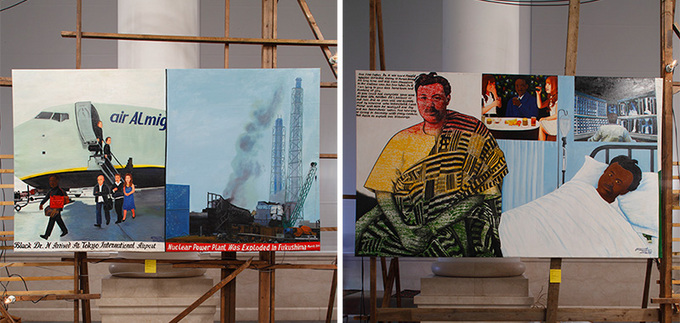
The tale of Dr. N is depicted in the distinct style of the popular illustrated signboards found on street corners in Africa. The paintings were made by Ghanaian painters.
References
Shigeru Nakayama, Noguchi Hideyo, Asahi Shimbunsha, 1978.
Junichi Watanabe, Toki rakujitsu (The Setting Sun in the Distance), Kadokawa Shoten, 1982.
Atsuko Yamamoto, Noguchi Hideyo shirarezaru kiseki (The Unknown Life of Hideyo Noguchi), Yamate Shobo Shinsha, 1992.
Taro Nishijima, Noguchi Hideyo no shinyu Hori Ichiro to sono chichi Rekizan (Hideyo Noguchi's Best Friend Ichiro Hori and His Father Rekizan), Harvest Publishing, 2012.
Matsue hanshi no musuko gakaninaru. mago shashinka ni naru (The son of Matsue clan retainer becomes an artist; the grandson becomes a photographer), Matsue History Museum, 2012.
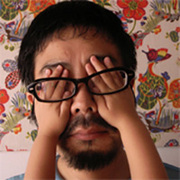 Tsuyoshi Ozawa
Tsuyoshi Ozawa
Born in 1965 in Tokyo. As a student at the Tokyo National University of Fine Arts and Music, Ozawa began his Jizo-ing series in which he photographs statues of Jizo that he makes himself situated in different environments. In 1993, he began his Nasubi Gallery series of portable, miniature galleries made from milk boxes, and his Consultation Art. In 1999, he produced his Museum of Soy Sauce Art remakes of masterpieces from Japanese art history painted with soy sauce, and in 2001, began his Vegetable Weapon series of photographic portraits of young women holding weapons made of vegetables. He had his first solo museum exhibition "Answer with Yes and No!" at the Mori Art Museum, Tokyo in 2004, and among his solo exhibitions since is "The Invisible Runner Strides on" held at the Hiroshima City Museum of Contemporary Art in 2009.
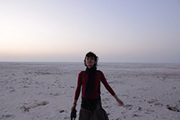 Masakatsu Takagi
Masakatsu Takagi
Visual artist and musician Masakatsu Takagi was born in 1979, and lives in Kyoto prefecture. His art includes both filmmaking--incorporating animation or video that he has shot and edited himself--and composing and performing music using computers or piano, an instrument that has long been his favorite.His CDs and DVDs have been released by Japanese and international labels, and he is active in a variety of fields, holding exhibitions at art museums and performing concerts worldwide. In addition to his own creative work, he has toured the world with David Sylvan, produced music videos for performers such as UA and YUKI, and been involved in many joint projects, including collaborations with the Institute for Art Anthropology, RIKEN, Audi, and NOKIA. In 2009, his growing global reputation as an artist led Newsweek Japan to list Takagi as one of the "100 Japanese People The World Respects." Recently he composed the music for Mamoru Hosoda's 2012 movie "Wolf Children (Ookami Kodomo no Ame to Yuki)."
Yukie Kamiya
Yukie Kamiya is Chief Curator at the Hiroshima City Museum of Contemporary Art. Previously, she worked as Associate Curator at the New Museum of Contemporary Art, New York. For this program, she served as a curator of the Ozawa Tsuyoshi's "The Return of Dr. N." The numerous exhibitions she has curated/co-curated worldwide include solo shows by Cai Guo Qiang, Tsuyoshi Ozawa, Do Ho Suh and Simon Starling at the Hiroshima MoCA, and "Thermocline of Art: New Asian Waves" (2007, ZKM, Karlsruhe), and "Re: Quest-Japanese Contemporary Art since the 1970s" (2012, Museum of Art, Seoul National University). Kamiya is also a contributor of "Creamier: Contemporary Art in Culture" (Phaidon, 2010), and a visiting lecturer at Waseda University.
African Film Screenings
During the exhibition period, the Japan Foundation hosted African Film Screenings that showcased a total of about 30 feature films and short films, depicting Africa as seen by African directors. African films are not widely shown in Japan, and many people in the audience commented the films enhanced their interest in Africa.
Related Events
Keywords
- Photo
- Film
- Arts/Contemporary Arts
- Music
- Medical/Health
- History
- Japan
- United States
- Ethiopia
- Ghana
- Africa
- Fukushima
- Tokyo International Conference on African Development
- TICAD
- Yokohama Creativecity Center
- Hideyo Noguchi
- Hiroshima City Museum of Contemporary Art
- Inawashiro
- Yellow fever
- Aizu-Wakamatsu
- Kitasato Institute
- Yokohama quarantine station
- Plague
- Rockefeller Institute for Medical Research
- New York
- Ichiro Hori
- Hikoma Ueno
- Broadway
- Typhus
- Meiji Restoration
- Sino-Japanese War
- Russo-Japanese War
- World War I
- Imperialism
- Beppu Contemporary Art Festival
- Taro Yasuno
- Great East Japan Earthquake
- Hiroshima
- Nagasaki
Back Issues
- 2023.12. 7 Movie Theaters aroun…
- 2023.6.16 The 49th Japan Found…
- 2023.4.24 The 49th Japan Found…
- 2022.12.27 Living Together with…
- 2022.12.27 Living Together with…
- 2022.8.12 Inner Diversity <…
- 2022.3.31 The 48th Japan Found…
- 2022.3.29 Beyond Disasters - T…
- 2021.11.29 Crossing Borders, En…
- 2021.4.13 Crossing Borders, En…



